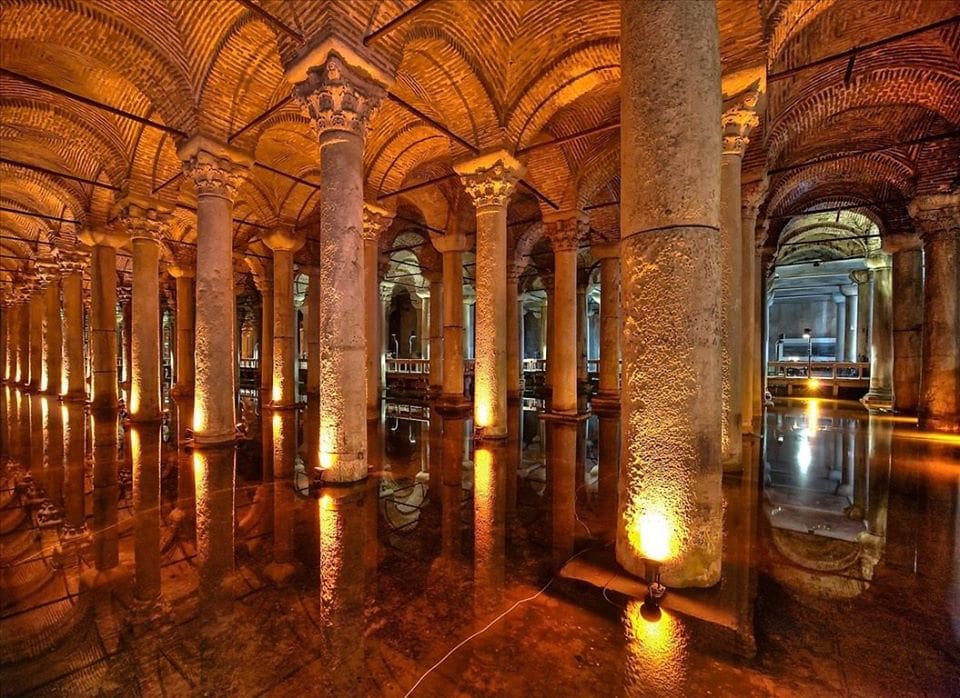Immerse yourself in the mysterious allure of Istanbul’s Basilica Cistern, an ancient marvel hidden beneath the city’s bustling streets. Our guide introduces you to this awe-inspiring underground reservoir, its historical significance, and the fascinating sights you can expect to encounter.

Brief History of Basilica Cistern
The Basilica Cistern, known as “Yerebatan Sarnıcı” in Turkish, was built during the reign of Byzantine Emperor Justinian I in the 6th century. This incredible engineering feat was designed to store water for the Great Palace and surrounding buildings.
What to See and Do
As you descend into the cistern, you’ll be captivated by the atmospheric lighting illuminating its 336 columns. Don’t miss the enigmatic Medusa-head column bases in the northwest corner – their sideways and upside-down placements remain a mystery to this day.
5 Basilica Cistern Facts
- Largest of Hundreds: The Basilica Cistern is the largest of several hundred ancient cisterns that lie beneath the city of Istanbul. It covers approximately 9,800 square meters, capable of holding 80,000 cubic meters of water.
- Forest of Columns: The cistern is known for its forest of 336 marble columns, each 9 meters high, arranged in 12 rows of 28 columns. These columns were repurposed from ruined buildings and display a variety of decorative styles.
- Medusa Mysteries: Two columns rest on blocks carved with the head of Medusa. The origin and purpose of these Medusa heads are unknown, making them a fascinating mystery. Interestingly, one head is placed upside down and the other is placed sideways, which has led to various theories about their symbolism.
- Hidden for Centuries: After the Ottoman conquest, the Basilica Cistern fell into disuse and was largely forgotten until it was rediscovered in the 16th century. Its full renovation didn’t take place until the 1980s.
- James Bond Connection: The Basilica Cistern became a popular tourist attraction and has been featured in several films and books. Notably, it appeared in the 1963 James Bond film “From Russia with Love.”

Frequently Asked Questions
Is Basilica Cistern worth it?
Yes, the Basilica Cistern is worth visiting due to its historical significance, unique architecture, and the intriguing mystery of its Medusa columns.
What is special about Basilica Cistern?
The Basilica Cistern is special for being the largest ancient cistern in Istanbul. It’s also famed for its beautiful forest of 336 columns, the eerie atmosphere, and the two mysterious Medusa-head column bases.
How many cisterns are there in Istanbul?
There are hundreds of ancient cisterns in Istanbul, but only a few are open to the public. Besides the Basilica Cistern, the most notable ones include Theodosius Cistern and Aetius Cistern.
When was the Basilica Cistern built?
The Basilica Cistern was built in the 6th century during the reign of Byzantine Emperor Justinian I.
Is there a dress code for the Basilica Cistern?
There’s no specific dress code for visiting the Basilica Cistern. However, comfortable clothing and footwear are advised due to the damp environment and uneven surfaces.
Best Time to Visit Basilica Cistern
It’s best to visit the Basilica Cistern early in the morning or later in the afternoon to avoid crowds. The low light during these hours also adds to the site’s eerie beauty.
Practical Information
Opening Hours: The Basilica Cistern is open daily from 9:00 am to 5:30 pm.
Entrance Fee: There is an entrance fee to visit the Basilica Cistern. It is 350 TL (around €12) as of June 2023
Location: The Basilica Cistern is located in the Sultanahmet district, just southwest of Hagia Sophia.
Insider Tips: Bring a jacket as the underground cistern can be chilly. Also, use the opportunity to capture some fantastic photographs – the unique lighting offers great shots.
Nearby Attractions: Other attractions close to the Basilica Cistern include Hagia Sophia, the Blue Mosque, and Topkapi Palace.
Conclusion: With its breathtaking Byzantine architecture and mysterious history, the Basilica Cistern offers a unique journey into Istanbul‘s past. We encourage you to delve into its depths and share your experiences with us!

